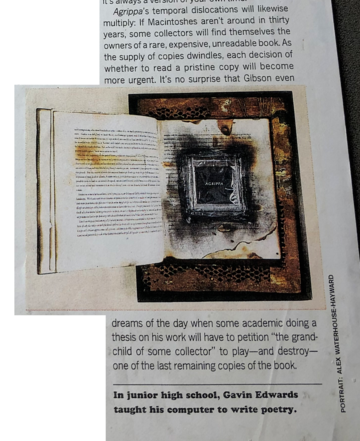
Agrippa (A Book of the Dead), by novelist William Gibson, artist Dennis Ashbaugh and publisher Kevin Begos Jr., 1992
‘Dreams of the day when some academic doing a thesis...’
This October I finally resumed my series of archive trips to the Bodleian Library, the external partner for my Collaborative Doctoral Award with the University of Cambridge.
My PhD research focuses on ‘the access to and the preservation of the self-destructive book within the framework of the library’, for which my case study is the 1992 American artist’s book Agrippa (a book of the dead). Its makers, the writer William Gibson, the artist Dennis Ashbaugh, and the publisher Kevin Begos Jr, made it so that it would self-destruct in analog form and be digitally encrypted to self-erase.
The deluxe and the small edition copy of Agrippa as well as its publisher’s archive in the Special Collections at the Bodleian constitute my main resources for this case study. With the current pandemic situation it had been months since I was able to go back and look at the books and leaf through Begos’s archive. Not only had I missed the library atmosphere, and the regular ‘in person’ catch-ups with friends and former colleagues in Bodley, but also I had missed the time that I can fully dedicate to my case study only when I am there. Of course, I have pictures of the archive and of the books, and I have been able to work on these remotely, but it is not the same as physically digging through the archive to find yet another piece of evidence which will help me to put together the puzzling making-process of this (literally) cryptic artefact. Agrippa stands described in the archive as a book entity, but materially it only exists scattered in its various copies, and their various conditions and stages in the making-process, including those within the framework of the Bodleian.
This is why it is so important for me to research the book materials and their archive within its own repository, in the reading-room (without gloves but with clean hands and a mask!), because it enables me, as a researcher, to grasp the very context and content of my own findings, as they appear to have been foretold by Agrippa’s writer: ‘it is no surprise that Gibson even dreams of the day when some academic doing a thesis on his work will have to petition “the grandchild of some collector” to play – and destroy – one of the last remaining copies of the book.’
Gavin Edwards, ‘Cyber Lit’, Details, June 1992, p. 134; Oxford, Bodleian Library, MS. Eng. c.7981, fol. 3.